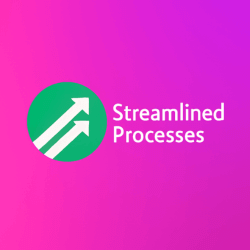For Automated Payment Processing, see our main page here.
What Is Automated Payment Processing?
Automated Payment Processing refers to the use of software and technology to manage, authorize, and complete financial transactions without manual input. It allows businesses to streamline billing, eliminate human error, and speed up cash flow.
For example, when a customer buys a subscription or service online, the system automatically charges their saved payment method on a recurring basis. This reduces the need for paper invoices, phone calls, or manual data entry. As a result, companies gain efficiency and accuracy in managing payments.
Automation also sends real-time notifications, updates balance sheets, and integrates with accounting platforms, making financial management less of a headache.
Why Businesses Are Embracing Automated Payment Processing
The rise in digital transformation across industries has made Automated Payment Processing a necessity rather than a luxury. Manual payment systems come with risks—lost paperwork, late payments, and limited scalability. However, automation addresses these challenges with confidence.
According to an industry report from PYMNTS.com and Mastercard, businesses that automate their payment systems saw a 67% faster invoice completion rate. Moreover, most companies reported improved vendor relationships and stronger audit trails.
In other words, it’s not just about saving time—it’s also about building trust and transparency.
Key Features of Most Automated Payment Systems
- Recurring Billing: Sets up automated cycles for customer payments, like monthly subscriptions.
- Fraud Detection: Monitors transactions in real-time to identify suspicious activity.
- Multi-Currency Support: Lets businesses accept payments from customers worldwide.
- Integration: Connects with CRM, ERP, and accounting tools for seamless updates.
- Customizable Workflows: Allows businesses to define rules for approvals, reminders, and thresholds.
These features give companies of all sizes the power to operate efficiently on a global scale.
How Automated Payment Processing Works Step by Step
- Payment Request: A transaction is triggered through an online checkout, invoice, or mobile app.
- Authorization: The system verifies customer credentials and credit availability.
- Processing: Funds are transferred through payment gateways and acquiring banks.
- Confirmation: Both business and customer receive payment status notifications.
- Reconciliation: Systems update ledgers, accounting entries, and reporting dashboards.
Each of these steps occurs in milliseconds behind the scenes, reducing errors and time spent on manual follow-ups.
Top Benefits of Automated Payment Processing
Many organizations choose this route to improve speed, safety, and scalability. Let’s break down the main advantages.
- Faster Transactions: Get paid quicker and more frequently with automated cycles.
- Lower Costs: Reduce labor and paper-related expenses.
- Improved Accuracy: Eliminate data entry errors common in manual processes.
- 24/7 Availability: Payments occur outside of business hours without extra staff.
- Customer Satisfaction: Clients enjoy smooth, interruption-free experiences.
Most importantly, businesses can allocate time to higher-value activities instead of chasing payments.
Industry Case Study: SaaS and Subscription Businesses
Software-as-a-Service (SaaS) companies were among the first to adopt Automated Payment Processing. With users subscribing monthly or annually, manual billing quickly became unsustainable. Companies like Dropbox and Slack saw rapid scale only after automating payment cycles, tax collection, and usage tracking.
Consequently, Automated Payment Processing has become essential for fast-growing subscription models. This includes online streaming, gym memberships, and professional service retainers. Whether you manage five or 500,000 users, automation keeps everything flowing smoothly.
Types of Payment Options Typically Supported
Automated systems support a wide range of payment methods to match customer preferences:
- Credit and Debit Cards (Visa, MasterCard, AMEX, etc.)
- ACH transfers and direct debits
- Digital wallets like Apple Pay, Google Pay, or PayPal
- Cryptocurrency (in limited use cases)
- Buy Now, Pay Later models
Having this variety makes it easier to close deals and improve conversion rates. Furthermore, systems automatically detect international platforms and comply with local tax laws.
Common Challenges and How to Overcome Them
Despite its strengths, Automated Payment Processing comes with hurdles. System compatibility, security risks, and compliance can become roadblocks without proper planning. For example, failing to update encryption settings could put customer data at risk.
To prevent issues, follow best practices:
- Choose a payment processor with PCI-DSS compliance.
- Regularly test for system vulnerabilities.
- Ensure new platforms integrate with your accounting tools.
- Use multi-factor authentication for all back-end users.
With the right tools and vendor, these concerns can be minimized or completely avoided.
Trends Shaping the Future of Payment Automation
The future of Automated Payment Processing points to deeper AI integration, predictive analytics, and blockchain adoption. For instance, AI is being used to forecast payment risks and auto-flag high-risk transactions. Similarly, open banking APIs now allow more secure and personalized payment experiences.
In addition, companies are increasingly adopting real-time payment networks, such as RTP in the U.S. and SEPA Instant in Europe. These enable instant clearing and settlement, eliminating traditional delays.
This evolution will not only increase security, but also give businesses faster access to working capital.
FAQ: Answers About Automated Payment Processing
Q: Is Automated Payment Processing secure?
Yes. Most systems follow strict security protocols like PCI compliance, data encryption, and fraud monitoring technologies.
Q: Can it handle international transactions?
Absolutely. Automated platforms support multiple currencies, languages, and global tax requirements.
Q: Does it work for small businesses?
Yes. In fact, small businesses greatly benefit from reduced admin time and improved cash flow.
Q: How long does implementation take?
That varies. A simple integration can take hours. Complex setups may need days or weeks, depending on legacy systems.
Q: Can I still send manual invoices if needed?
Of course. Automated systems often allow manual overrides or custom billing setups when required.
Conclusion
Automated Payment Processing offers a smarter, safer, and faster way for businesses to manage their payments. From reducing errors to improving financial forecasting, it transforms how organizations handle money. Whether you’re a startup or an enterprise, automation supports your growth without adding complexity.
This article was created with the assistance of AI tools and reviewed by our team at Streamlined Processes LLC to ensure accuracy and relevance.
Follow us on Facebook here.

